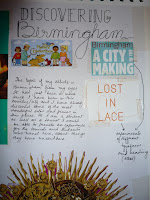This week I am supposed to write an article on certain principles to be used in Art and I have chosen the following Principle: Drawing, and the other Principle of Utilizing the creative brain. As far as studying an artist who uses his sketchbooks to think on the page both graphically (using drawings and illustrations) but also uses a method of annotating what his work is about, to keep a track on what he was thinking, I feel that Leonardo Da Vinci is the best example. His ability to think on the page and also annotate his drawings portrays a clear example of how a creative brain works.
 |
| Madonna and Jesus |
“To develop a complete mind: Study the science of art; study the art of science. Learn how to see. Realize that everything connects to everything else.”
 |
| Sketchbook pages |
Da Vinci is called a man of “both” worlds for his ability to encompass the two different world of Art and Science and combine them on a single plane. This is the one trait that led to him making amazing scientific discoveries that no other artist could reproduce. He was a scientifically based painter who was able to depict on a 2D surface, the movements/turnings of the major parts of the human anatomy. He used this as a design speculation for many of his paintings and also to create a creative play among his paintings, which could be seen through his painting of the Jesus and Virgin Mary. That is the reason the painting always seems to face the observer no matter where they are standing. That is what he based his paintings of The Mona Lisa and the Last Supper on. No doubt he was a creative genius and that is not only shown through his masterpieces but by seeing the amount of planning and gone into it.
Another example that I found is of an illustrator named Tom Gauld and his work for the Guardian, entitled The Street Tom Waits Grew up on, his sketchbook pages showing his ideas and the evolution of those ideas from lists and drawings to his final work. It was nice to see the large amount of ideas that were listed that led to the final piece. It made me understand the importance of exploring a large number of potential ideas on paper before going on and deciding on the final piece. Through the magazine that we are designing a large number of ideas are being accumulated so that the best idea could be selected and it also gives us an idea about what we want, what looks good and what not to put in.
 |
| Sketches for The Street Tom Waits grew up on |
The other principle that I have chosen to explore is how both the right and the left side of the brain can be utilised to make the best use of your creativity. Using Tom Gaulds example we could see how he uses the playful right side of his brain, through his use of drawing cartoons and doodling, and his left side of the brain to make lists and annotations to give a sort of direction to his drawings and push his ideas forward, so that a completed picture can emerge.
 I have learned through my work on my RVJ and my sketchbook that I did for my A levels, fine art portfolio how important drawing on paper is, but also the small notes and annotations that go with it are important to produce the best of works, and that even the greatest of artists like Leonardo Da Vinci went through this process which is how he was able to create his masterpieces. These pages from my RVJ show my attempt to utilize these principles in my own work which will hopefully lead on to the best possible outcome, in the shape of a good magazine.
I have learned through my work on my RVJ and my sketchbook that I did for my A levels, fine art portfolio how important drawing on paper is, but also the small notes and annotations that go with it are important to produce the best of works, and that even the greatest of artists like Leonardo Da Vinci went through this process which is how he was able to create his masterpieces. These pages from my RVJ show my attempt to utilize these principles in my own work which will hopefully lead on to the best possible outcome, in the shape of a good magazine.
No comments:
Post a Comment